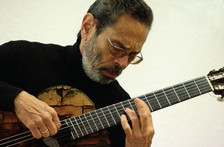
Leo Brouwer (1939), composer, guitar player and conductor, was born in Havana into a musical family. Musically encouraged by his father, an amateur guitarist, he began playing the guitar when he was 13. Brouwer gave his first performance at 17 and soon began to compose music as well. His early compositions include Prelude (1956) and Fugue (1959), both influenced by Béla Bartók and Igor Stravinsky. In 1959, he continued his musical education in the United States, studying composition at Juilliard School and at Hart College in Hartford. Returning to Cuba, he began active work in film industry; he has scored over 50 films, including international hits. He was also named director of the experimental department of the Cuban Institute of Cinema Arts and Industry. Between 1961 and 1967, he taught composition at the Music Conservatory of Havana. In 1981 he was appointed principal conductor of the Orquesta Sinfónica Nacional de Cuba. His varied output includes many works for guitar, percussion, prepared, and non-prepared piano, a ballet, and several orchestral pieces. Brouwer’s early compositions reflect the influence of Cuban folk music, while his later works veer toward a more minimalist style. In the mid-1960s, Brouwer was intensely involved in the Cuban avant-garde, inspired by the music he heard at the 1961 Warsaw Autumn Festival. Brower was the first Cuban composer to use aleatory and open forms in his compositions. In 1980, however, he turned to what he called a ‘new simplicity’, incorporating minimalist elements with a return to Afro-Cuban roots, creating what he describes as ‘national hyper-romanticism’.
Brouwer composed his Sonata for solo guitar in 1990, for the great guitar player Julian Bream, who first performed it the following year. The first movement combines fandango, the fast Spanish dance of Andalusian origin, and bolero, the Spanish dance of moderate tempo in triple time. The second movement is inspired by a sarabande in the style of Alexander Scriabin. In the finale, Brouwer quotes and remixes the toccata technique from the popular Toccata con lo Scherzo del cucco by Italian composer Bernardo Pasquini.


